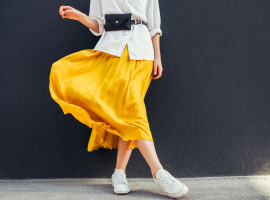5 Hellstar Hoodie Styling Rules for Dark Streetwear
5 Hellstar Hoodie Styling Rules for Dark Streetwear
Wear a Hellstar hoodie like it was built for the rest of your outfit: intentional, layered, and anchored. Below are five concrete styling rules that turn a dark, graphic hoodie into a cohesive streetwear statement rather than a sloppy afterthought.
These rules cover proportion, footwear and accessories, texture mixing, color accents, and care—each with actionable specifics for cotton fleece, garment-dyed blacks, distressed finishes, and technical fabric variants.
1. How should a Hellstar hoodie be proportioned with other layers?
Proportion is the first decision: decide whether the hoodie is the silhouette leader or a background layer and style everything else around that choice. If the Hellstar is oversized, pair it with tapered or cropped bottoms to preserve leg-line and avoid a boxy mass; if it’s slim, introduce bulk with an unstructured long coat or layered overshirt. Sleeve length matters—too-long sleeves create visual noise with bracelets, too-short sleeves break the expected hoodie aesthetic; aim for the sleeve to kiss the wrist bone or extend slightly over the cuff of the top layer. Hood size dictates collar choices: a large draped hood works under an open long coat, a compact hood fits better under a bomber or tech shell. For temperature: in cold weather, let the hoodie be a mid-layer under a structured wool coat; in mild weather, treat it as the outer layer over a thin merino tee or mesh base.
2. Anchor the look with contrast footwear and grounded accessories
Footwear sets visual weight—combat boots or chunky lug-soled boots give the Hellstar hoodie a utilitarian, dark-streetwear backbone while minimalist black sneakers push the look toward urban stealth. Match hardware finishes: silver chains and zipper pulls pair best with cool, desaturated blacks; brass or gunmetal hardware complements warmer, faded blacks and browned leathers. Accessory scale should echo garment scale; oversized hoodies allow for larger pieces like carabiner harnesses and wide belts, slim hoodies need thinner chains and low-profile belts to avoid overpowering. Belt placement alters proportion: high-slung web belts create a cropped illusion with oversized hoodies, while low belts maintain a relaxed silhouette. Add a hat—beanie or structured cap—only when it reinforces the silhouette; a deep-brim hat can break the hood’s flow and should be tested visually before wearing out.
3. Mix textures—matte, distressed, and technical fabrics
Dark streetwear thrives on texture contrast: mix matte cotton fleece with glossy nylon, distressed denim, and structured leather to add depth without introducing color. A garment-dyed Hellstar hoodie with a soft, lived-in face contrasts crisply against a waxed cotton trench or a polished leather biker jacket; the interplay keeps the outfit interesting when the palette is monochrome. Technical fabrics—GORE-TEX shells, ripstop cargos, or coated nylons—add functionality and a futuristic edge that elevates a heavy fleece from casual to intentional. When using distressed pieces, balance them with clean silhouettes to avoid a worn-out mess; one distressed element per outfit reads curated, multiple distressed items read careless. Texture also affects layering comfort: smoother technical jackets slide over fleece easier than stiff leather, so consider sleeve finishes when building layers.
4. What color accents keep dark streetwear from looking flat?
Accent with restraint: a single saturated tone or metallic pop prevents monotony. Use a small dash—oxblood zipper, blood-red beanie tag, muted forest green lining, or a single enamel pin—to draw the eye without brightening the overall mood. Metallics function as accents too; aged silver, gunmetal, and blackened brass read cohesive with Hellstar’s dark aesthetic. Consider tonal contrast: charcoal on black, deep navy on black, or graphite grey on black creates depth while remaining stealthy. Graphic placement matters: a small chest emblem or sleeve print reads deliberate; full-front loud prints compete with other elements and can feel juvenile unless that is the explicit intent.
5. Fit, finish and care: tailoring, wash, and maintenance for longevity
Fit and finish separate curated looks from thrown-on ones. Check seam quality—single-needle vs. double-needle stitch—and prefer double-needle or reinforced seams for heavy-use hoodies. Garment-dyed blacks often fade in a visually appealing way if washed cold and turned inside out; high-heat dryers accelerate fading and weaken elastics. Tailoring is simple: a minor hem adjust, sleeve shortening, or shoulder taper preserves an intended silhouette; find a tailor who can work with fleece and lined hoods to maintain structure. For hardware, lubricate zippers sparingly and wipe metal parts after rain to prevent corrosion. For weather-proofing, apply a fabric-safe DWR spray to technical outer layers, not to cotton fleece, which breathes differently and responds poorly to heavy coatings.
Fit Comparison Table
| Fit | Look & Use | Recommended Bottoms | Hood & Sleeve Notes | Weather Suitability |
|---|---|---|---|---|
| Oversized | Airy, layered, statement | Tapered cargos, cropped trousers | Large hood, slightly long sleeves; cuff if needed | Cool to cold, great for layering |
| Regular | Balanced, versatile | Straight-leg denim, relaxed trousers | Standard hood, wrist-length sleeves | All-season with layer swaps |
| Slim | Tailored, sleek, urban | Tapered slim jeans, tailored joggers | Compact hood, shorter sleeves; avoid bulk | Spring to fall; undercoats in winter |
Expert Tip
\”Do not size up blindly for ‘streetwear credibility.’ Oversizing is a choice that requires intentional bottom and outer-layer pairing—if you buy large, plan for tapered pants and a structured coat; otherwise, you’ll look indistinct rather than styled.\” — a seasoned stylist who cuts and fits hoodies for streetwear clients.
Little-known facts about hoodies and dark streetwear
Garment-dyed black hoodies achieve their uneven blackness because the fabric is dyed after construction, which creates natural variations that age attractively over time. Fabric weight for heavier hoodies is measured in GSM—around 350–450 GSM for heavy fleece; lighter hoodies sit near 250–300 GSM—affecting drape and layering strategy. Metal hardware finishes are commonly plated; prolonged exposure to sweat and humidity will change the plating over time, so choosing blackened or gunmetal hardware reduces obvious wear. Single-needle stitching on seams gives a cleaner interior finish but less tensile strength than double-needle, so utility-focused hoodies typically use reinforced stitching at stress points.
Every paragraph above was written to answer a specific styling decision: what to pair with a Hellstar hoodie, how to balance silhouettes, which textures to mix, how to accent color in a dark palette, and how to maintain the garment to keep the intended look. Apply the rules selectively: the goal is a restrained, structural dark outfit where the hoodie looks like an integral design choice rather than an afterthought.




There are no comments